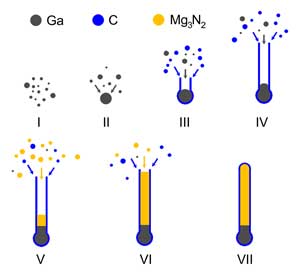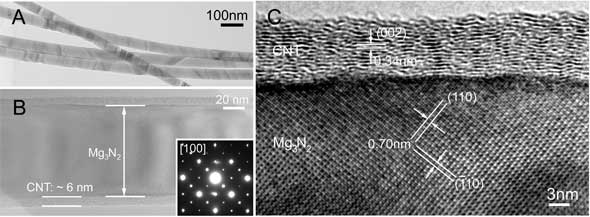| Posted: Jun 28, 2006 | |
A novel fabrication of magnesium nitride nanowires in nanoreactors |
|
| (Nanowerk Spotlight) Carbon nanotubes (CNTs) have been used as nanoreactors in a simple thermal reaction process for the fabrication of high-quality, large-yield single-crystalline Mg3N2 nanowires. These nanowires are homogeneously sheathed over the entire lengths with very thin graphitic carbon tubular layers, which effectively prevent the decomposition in the presence of water in the atmosphere. | |
| In a recent article, titled "Carbon Nanotubes as Nanoreactors for Fabrication of Single-Crystalline Mg3N2 Nanowires" first author Dr. Junqing Hu, Independent Research Fellow at the International Center for Young Scientists (ICYS) in Japan, together with Prof. Yoshio Bando and Prof. Dmitri Golberg, both from the National Institute for Materials Science (NIMS), have developed CNTs as nanoreactors for the first fabrication of single-crystalline Mg3N2 nanowires, and have systematically analyzed for the first time this nanomaterial by means of transmission electron microscopy (TEM), high-resolution TEM and electron diffraction. | |
 |
Schematic illustration of the growth process of a Mg3N2 nanowire coated with CNT: (I) Ga vaporizing, (II) Ga vapor condensing to form a Ga droplet, (III) CNT nucleating, (IV) CNT continuously growing and in situ Ga filling within it, (V) and (VI) a Mg3N2 nanowire continuously growing inside CNT, (VII) CNT sealing. (Source: Dr. Junqing Hu) |
| Hu described the background of their research to Nanowerk: "Magnesium nitride is a direct energy gap semiconductor (∼2.8 eV) and may serve as a potential high-temperature semiconducting material and/or component of a semiconductor heterostructure useful in nanoelectronics. Due to fast decomposition of Mg3N2 in the presence of water in the atmosphere, the synthesis of single-crystalline Mg3N2 nanowires has not yet been accomplished and remains a challenge." | |
| Due to the characteristic internal cavity, CNTs can serve as nanoreactors for introducing reactive species and reactants, followed by desired reactions with an aim to produce nanowires (that can not be synthesized under normal conditions) in the confined configurations. The resulted products are homogeneously sheathed with graphitic carbon tubular layers, which effectively prevent the decomposition (including surface oxidation and/or hydrogenation) of as-synthesized nanowires. | |
 | |
| (A) TEM images showing that Mg3N2 nanowires have a uniform diameter along the length. The inset depicts the ED pattern of this wire. (B) High-magnification TEM image showing a uniform and thin carbon sheath on a Mg3N2 nanowire. (C) (Source: Dr. Junqing Hu) | |
| "The formation of single-crystalline Mg3N2 nanowires sheathed with CNTs proceeds via a simple thermal reaction process using MgB2, Ga2O3, activated carbon powders, and N2 as source materials" explains Hu. "The reaction of Ga2O3 and activated carbon at a processing temperature (∼1200°C) in a N2 flow resulted in the CNT growth via a Ga-catalyzed vapor-liquid-solid process. In the growth process of a Mg3N2 nanowire, as-formed CNT acts as a reactor. The reactive species including Mg vapor and N2 are then transported by carrier gas (N2) and enter the CNT to produce Mg3N2 nucleus, and the CNT will confine the 1D nanowire growth inside the tube. As a result, CNT serve as a coating on the Mg3N2 nanowire." | |
| "Fabrication of carbon layer stably preserving magnesium nitride nanowires may promote further experimental studies on their properties and crystal structures" says Hu. "The developed "CNT as nanoreactor" method might be useful for the formation of protective carbon coatings on the III-V and II-VI semiconductor nanowires in order to prevent their surface oxidation and/or hydrogenation." | |
 By
Michael
Berger
– Michael is author of three books by the Royal Society of Chemistry:
Nano-Society: Pushing the Boundaries of Technology,
Nanotechnology: The Future is Tiny, and
Nanoengineering: The Skills and Tools Making Technology Invisible
Copyright ©
Nanowerk LLC
By
Michael
Berger
– Michael is author of three books by the Royal Society of Chemistry:
Nano-Society: Pushing the Boundaries of Technology,
Nanotechnology: The Future is Tiny, and
Nanoengineering: The Skills and Tools Making Technology Invisible
Copyright ©
Nanowerk LLC
|
|
Become a Spotlight guest author! Join our large and growing group of guest contributors. Have you just published a scientific paper or have other exciting developments to share with the nanotechnology community? Here is how to publish on nanowerk.com.
